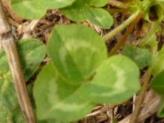Alfalfa Facts
Learn about this valuable legume, and why I use it in my organic garden
Alfalfa is one of the most often used and valuable plants for animal feed, and has many other uses in the garden too.
See these interesting alfalfa facts :
- As a nitrogen fixing plant, (a legume) it has the ability to glean nitrogen from the air and store it in its tissues, particularly in nodules on the roots.
Held captive there, the plant releases the nitrogen to other subsequent crops once the plant is tilled in, or the top of the plant is cut to make hay or silage.
- Farmers and those who raise livestock know that alfalfa has great nutritional value, and in some cases is such a rich feed that it must be used in moderation - horses and cows can 'founder' or have other problems due to the heat produced by the fermentation of the plant in their gut.
- Alfalfa has the highest nutrient value of any forage crop.
- Animals fed alfalfa get the benefit of the nutrients too, and their manure is also more valuable.
- Chickens love getting a few handfuls of the growing leaves, and as a bonus the eggs you get will be bright golden yellow.

- One of the benefits of alfalfa in your garden is when it's grown as a cover crop, the roots can reach an incredible depth in the soil, bringing up nutrients from way down.
The channels made by the roots also create a highway for the roots of less aggressive plants to follow to find nutrients lower down in the soil column.
- When the alfalfa crop is cut for mulch, or dug in as green manure, these nutrients are added to the soil.
- Processing alfalfa into alfalfa pellets was probably one of the most useful innovations.
These small extruded pellets of shredded and pulverized alfalfa are chock full of the same nutritional benefits of hay, with none of the waste.
Use them as a slow release fertilizer around your plants for the best use of this valuable resource.
- Blister beetles are renowned for their love of alfalfa – use caution handling alfalfa hay, or when cultivating it in your garden as mulch.
The blisters that these insects cause can cripple a horse or cow, and leave serious burns on unprotected hands.
See more about blister beetles .
- In addition to these uses alfalfa is also great butterfly and bee fodder, and you know it must be extremely tasty because deer will jump fences and brave almost anything to get to it, either growing in the field, or as hay.
How to grow alfalfa;
Scattering a small amount of the fine seed will give you a great crop of this plant.
Spread it extremely thinly, as although the plants take a while to reach full size, in time each one will be over 60cm (2’) across.
They prefer a gravel soil, and don’t need much added nutrients in the soil, given their ability to glean their own nitrogen right out of the air.
Bees and butterflies relish the nectar of these leguminous plants, no surprise there.
In July when they bloom, the scent of alfalfa will make your head spin, it’s so sweet.
The scent of drying hay is equally as delicious.
In August, you may find alfalfa plants with strange twisted growths on them - these are the seed pods.
Collect them and put them into a paper bag to dry and soon the pods will open, spilling the seeds into the bottom of the bag.

Sprinkle them sparingly on top of the snow in the spring to make your own alfalfa meadow.
To find out more about my secret method of insulated worm farming, sign up for the Composting E-Course (your free bonus when you subscribe to Out in the O-Garden Newsletter).
 Composting E-Course - sign up here
Composting E-Course - sign up here
Get the free Composting E-Course delivered right to your inbox and learn tips and tricks to get your compost to work the first time.
Get started now; fill out the form;












